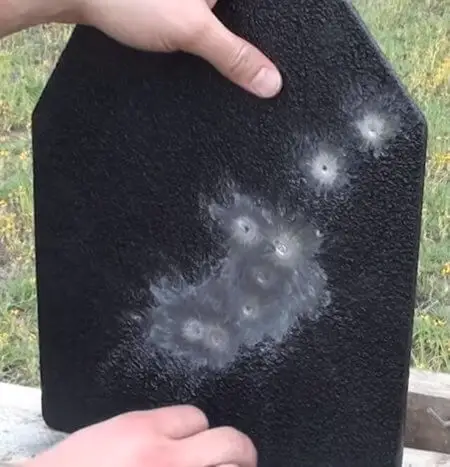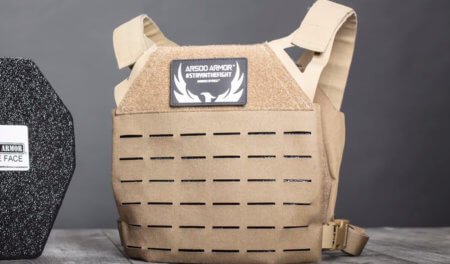Are you able to understand all the different ratings that come with body armor? They can be confusing, but they’re extremely important if your life is going to depend on it.
The National Institute of Justice (NIJ) says that level III body armor has to stop a 147 gr 7.62mm Full Metal Jacket round moving at 2780 ft per second. Hard armor and plate inserts tested with soft armor must be labeled as only providing level III protection when paired together.
Level III body armor makes a big jump up from level IIIA body armor. It consists of hard armor or a combination of both hard and soft armor which makes it capable of providing protection from most rifle rounds that aren’t specifically designed to defeat body armor.
What Does Level III Body Armor Protect Against?
The NIJ requires level III armor to stop up to a 7.62mm NATO round moving 2780 ft/sec. This means that it is capable of stopping most rifle rounds that you’re likely to encounter.
Level III armor is capable of defeating most rifle rounds. Steel plates are usually capable of protecting from 5.56mm green tip “penetrator” rounds while UHMWPE level III armor usually cannot.
Level III composite armor may or may not be able to stop green tip ammo, depending on the design of the plate itself.
| Body Armor Level | Effective Against These Calibers |
|---|---|
| III | .308 Winchester Full Metal Jacket = 7.62 X 51 mm NATO rounds at ~ 2,750 fps |
| IV | 30-06 Armor-Piercing .30 M2 AP One round at ~ 2,850 fps |
What Is Level III Body Armor Designed For?
Level III body armor hard armor that is designed to stop most common rifle calibers.
Level III armor is normally worn in an external carrier since its bulk and weight make it difficult to conceal. One of the better ways to conceal level III body armor is to carry it in a backpack or briefcase as part of your EDC.
Most companies offering level III body armor sell plates made from a range of materials. These include steel, composite materials, ceramic and ultra high molecular weight polyethylene (UHMWPE). Each comes with its own benefits and drawbacks.
When you’re choosing body armor, you have to understand the threats that you’re most likely to come across. You can be assured that most common rifle rounds and all pistol rounds will be stopped by level III armor plates and inserts.
In order to get the best protection available, you’ll have to go for level IV body armor adding weight, size, and cost.
AR 500 Armor and Spartan Armor Systems both sell high-quality body armor of all types.

Does Level III Body Armor Protect Against Anything Other than Bullets?
Level III body armor isn’t specifically designed to protect against anything other than what it is tested against. It does, however, offer some protection against fragmentation from IEDs and other explosive devices as well as bladed and piercing weapons.
Most of this protection comes from the simple fact that level III armor is made of dense materials and knives, piercing weapons and some frag have difficulty getting through it.
How Does Level III Body Armor Work?
Level III body armor functions in different ways depending on the materials used to make it.
Steel armor plates stop bullets be simply being very dense and strong. The bullet typically hits the armor and shatters into many smaller pieces.
Ceramic level III body armor plates are made with extremely hard non-metallic materials. These plates stop projectiles by deforming them as they pass through the ceramic material, reducing their energy and penetrating ability.
They are very good at stopping penetrating rounds but are much more delicate than steel or UHMWPE armor plates. They also suffer from relatively poor multi strike performance. To help counter these weaknesses, ceramic plates normally have some kind of metal, polyethylene or aramid fiber backing.
UHMWPE plates are made of sheets of specialized plastic pressed together to form dense, relatively light, armor that some claim is stronger than metal. The plates slow and deform the bullet as it passes through the UHMWPE material.
What Is Level III Body Armor Made Of?
Plates made from steel use steels specifically designed to be especially hard to stop projectiles as they strike the armor. These steels are tested to ensure uniformity in their thickness and density across the plate. They also normally have a layer to reduce bullet spalling. This rubber-like coating stops the spalling of rounds that impact the armor and prevent it from hitting the wearer in areas like their neck, arms and legs.
Steel level III armor plates are heavy making them difficult for some people to wear for extended periods of time. They have the benefit of being less expensive and not as thick as most other armor types.
Ceramic level III body armor is made of inorganic, non-metallic materials that are extremely strong. Some of the most common materials used in making ceramic armor is boron carbide and other materials like it.
The backside of ceramic armor plates usually have a ballistic backing of some kind to help give them more multi-strike strength. They tend to be lighter than steel armor but much more expensive.
Level III body armor made from UHMWPE is constructed from layers of polyurethane sheets and fibers pressed together under high heat and pressure. These plates are usually very thick compared to armor made from other materials but they are also extremely lightweight and they actually float.
UHMWPE armor does very well against multiple strikes and is more durable than ceramic plates. The downside is it should not be stored in high heat (like a car sitting in the sun) and can melt if it comes in contact with flames.

Is Level III Body Armor Legal?
This is where I need to give the obligatory disclaimer…I’m not a lawyer so only use this section as a guide. It is not legal advice.
Level III Body Armor Legality in the United States: In the United States it is illegal to possess body armor if you are a convicted felon. In Connecticut, it is illegal to ship body armor meaning that all sales must be made face to face. Many other states have made it a felony to commit a violent crime while wearing body armor. Others have made it illegal to wear body armor on school grounds. Check your local laws to be sure!
There has been some talk among politicians in the U.S. about making body armor illegal.
Level III Body Armor Legality in Canada: In Alberta, British Columbia, Manitoba, and Nova Scotia a license is required to possess body armor. In the remaining provinces, there are no restrictions.
Level III Body Armor Legality in the UK: In the United Kingdom, there are currently no legal restrictions on the purchase and ownership of body armor.
Level III Body Armor Legality in Australia: In Australia, it is illegal to possess body armor without proper authorization in South Australia, Victoria, Northern Territory, ACT, Queensland, and New South Wales.
How do You Choose What Type of Armor you Should Buy?
Start by determining the threats that you’re most likely to encounter. Ask yourself the following questions:
- Are you going to be facing pistol fire or rifle fire?
- Do you need knife or spike protection?
- Is it okay if others know that you’re wearing body armor?
With level III body armor you need to take the advantages and limitations of each type of armor into consideration.
Level III steel body armor is thin, inexpensive, very durable and lasts the longest amount of time without needing to be replaced. It’s also heavy.
Ceramic level III body armor is light compared to steel armor and stops penetrating rounds very well. It also comes with the drawbacks that it’s expensive, more delicate than other types of armor and has poor multistrike performance.
UHMPWE body armor is very light (often around 3.5 lbs per plate), has good multistrike performance and has the added benefit of floating in the water. If you plan on being near water or on a boat while wearing your armor, this could be the style of level III body armor for you. It does suffer from being thicker, relatively expensive and can have problems stopping penetrating style rounds.
Related Questions
What is hard body armor? Level III and hard body armor often refer to the same thing. When someone is discussing hard body armor they mean armor that doesn’t flex. Level III and IV body armors are considered hard body armor. Some level IIIa is made as hard body armor as well.
Does level III body armor expire? Level III body armor has a shelf life that depends on the construction of the armor. Steel body armor lasts 20 or more years with no maintenance. Ceramic and UHMWPE armor are typically said to have a 5-year shelf life.
How much does level 3 body armor weigh? The weight of level III body armor depends on what the plates are made of and their size. On average, steel plates weigh about 9 lbs each, UHMWPE plates are about 3.3 lbs and ceramic plates are around 3.5 lbs.

